
More people than ever are going to college. The share of Americans 25 and older with a bachelor’s degree increased from 5 percent in 1940 to 31 percent in 2016. But that doesn’t mean everyone who attends college is well positioned to cash in on their degrees.
There has been a lot of attention around helping students choose the right degree for in-demand careers. But even if they all choose perfectly, can labor markets provide the mix of jobs needed to ensure all college graduates can use their education?
In a brief released today, we calculated the “mix-match” between the share of people with college education—both “some college” and four-year degrees or more—and the share of jobs that typically require it in all 387 metropolitan areas. This blog post focuses on people with four-year degrees or more, but we also explore the mix-match for people with “some college” in our brief. (Download the full data here.)
We find that mix-matches between jobs requiring a college education and people who have that education are common. This challenge has far-reaching consequences for the labor market and requires local leaders to consider hiring and economic development strategies to improve the mix-match in their communities.
A mix-match of educational attainment and job requirements
Nationally, about 60 percent of people 25 and older have at least some college education. But the profile of jobs is roughly the inverse: 63 percent of jobs typically require a high school degree or less.
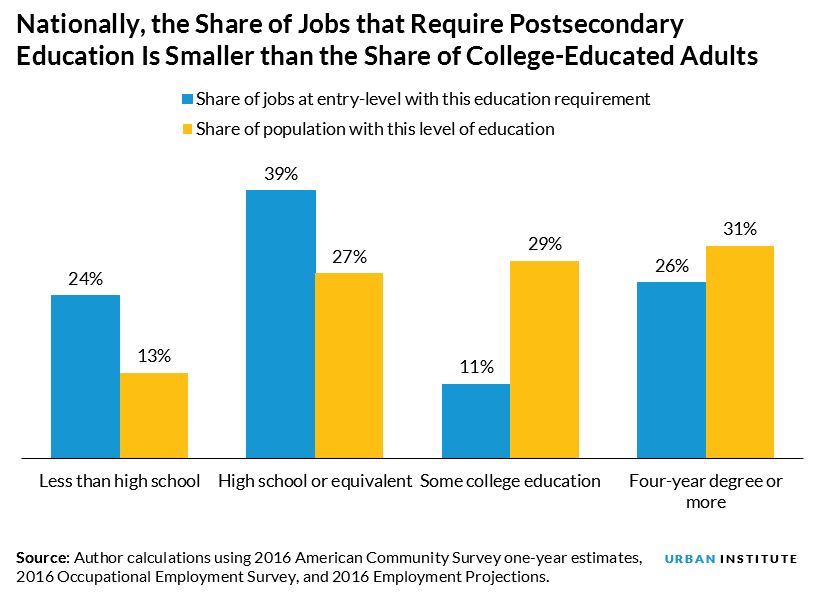
This labor market mix-match is unlikely to change soon. Although jobs requiring a four-year degree or more are predicted to increase faster than other jobs over the next eight years, their overall share of the job market will remain largely the same because they compose a relatively small share of the market.
College-educated people’s job opportunities differ depending on where they live. Eighty-seven percent of all metro areas, or 337 of the 387, have a labor market mix-match where the share of people with at least a four-year degree exceeds the share of jobs requiring this level of education, ranging from a 1 to a 32 percentage-point difference.
We also ranked metro areas by the size of the labor market mix-match. The top-ranking metro areas have a large share of jobs requiring a four-year degree relative to their college-educated populations. In these top-ranking metro areas with smaller mix-matches, people with a college degree likely have more opportunity to use that degree. In contrast, the bottom-ranking metro areas have bigger mix-matches where college educational attainment among local people outpaces the share of jobs that need it.
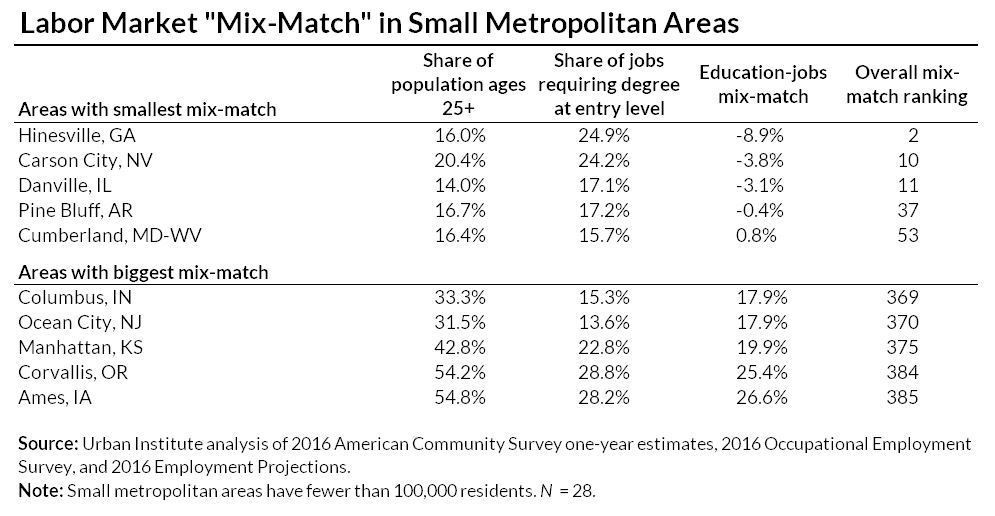
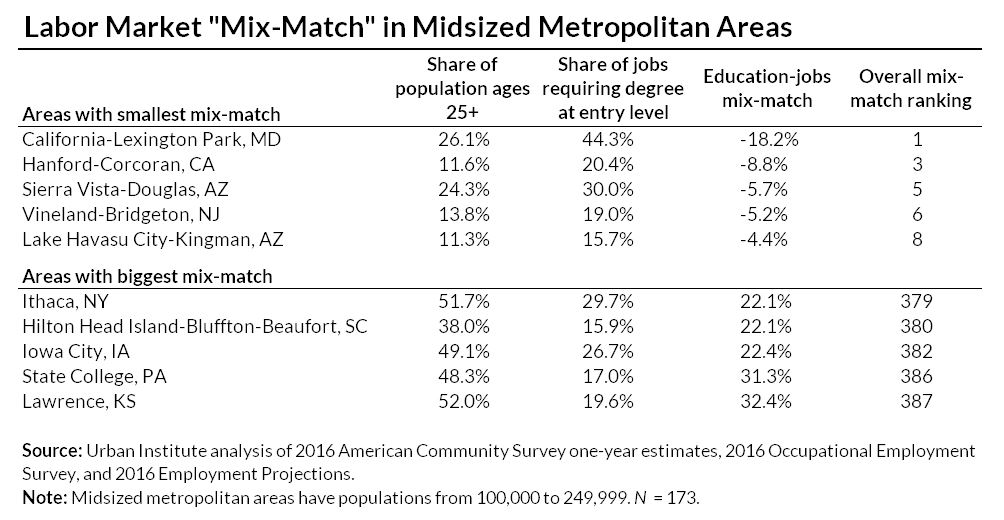
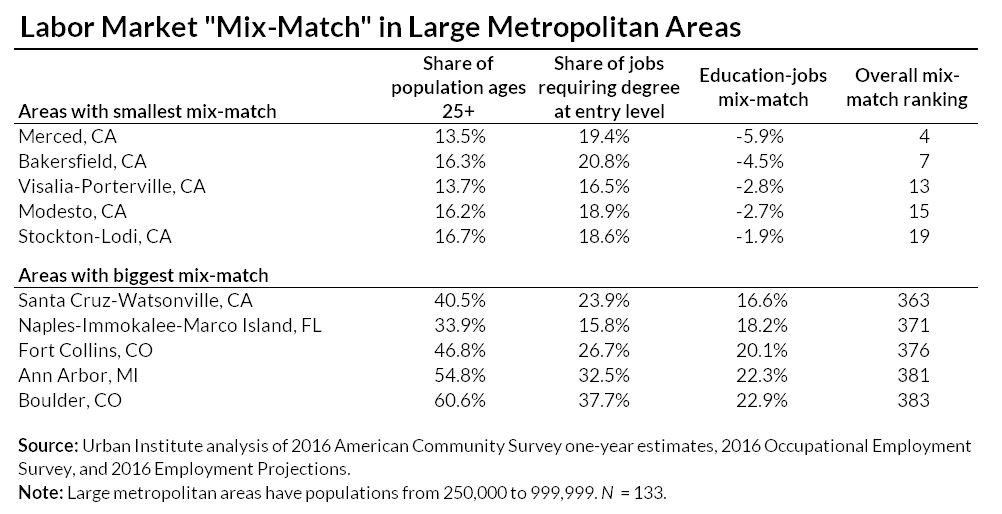
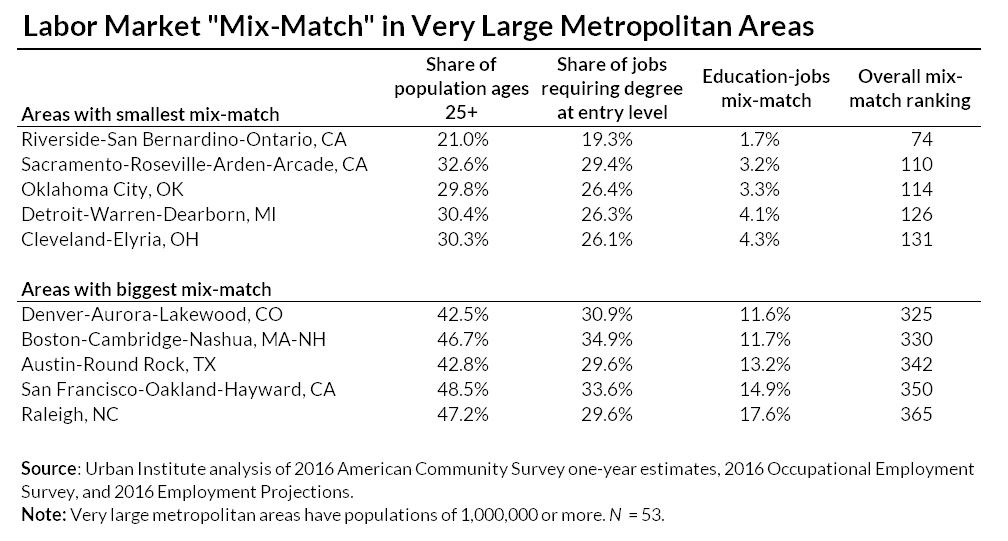
Many top-ranking metro areas, or ones with smaller mix-matches, have small shares of college graduates, including agricultural communities in the California San Joaquin Valley; postindustrial areas like Danville, Illinois; and vacation destinations like Lake Havasu City-Kingman, Arizona.
Other top-ranked areas are employment hubs with a high demand for educated workers. In California-Lexington Park, Maryland, home to Patuxent Naval Air Station and many aerospace and tech companies, the share of local college graduates isn’t keeping up with the outsized demand for college degrees in local jobs.
Among the bottom-ranking metro areas with bigger mix-matches are college towns with many people ages 25 and older with at least a bachelor’s degree, including small (e.g., Ames, Iowa), midsized (e.g., State College, Pennsylvania), large (e.g., Boulder, Colorado), and very large (e.g., Boston) metro areas.
There are also several bottom-ranking metro areas that have substantial mix-matches not because of high shares of college graduates, but because of their low shares of jobs requiring degrees. These include tourism economies like Ocean City, New Jersey, and Hilton Head Island-Bluffton-Beaufort, South Carolina.
How improving this mix-match can benefit communities
Mix-matches between education and jobs may make access to opportunity difficult for American workers. With so many people meeting basic educational requirements, employers can be overwhelmed trying to find the right person for a job. In response, they may inflate educational or experience requirements just to manage the process, and still not get people with the skills they need.
Workers end up needing to continuously upgrade their skills or education—not necessarily because the nature of jobs has changed-- but because of the need to compete with other workers with ever-increasing educational credentials for opportunities.
And if people with college degrees can’t find jobs where they can use their education, they may work in jobs that require less education, potentially earning less and displacing less-educated people who would have held those jobs.
We can’t fix this labor market problem with the traditional solution of sending more people to college. We need to rethink postsecondary education and consider investments in work-based learning that gives people the skills employers demand at a lower cost than traditional college. We also need to work with employers to explore ways to refine and expand skills-based hiring and other innovative practices that might slow the tide of credential inflation. And we need to pay much more attention to economic development as a strategy for ensuring opportunity in our communities.
Local people can’t live up to their full potential if there is no structure in place that empowers them to leverage their education and skills.
Tune in and subscribe today.
The Urban Institute podcast, Evidence in Action, inspires changemakers to lead with evidence and act with equity. Cohosted by Urban President Sarah Rosen Wartell and Executive Vice President Kimberlyn Leary, every episode features in-depth discussions with experts and leaders on topics ranging from how to advance equity, to designing innovative solutions that achieve community impact, to what it means to practice evidence-based leadership.